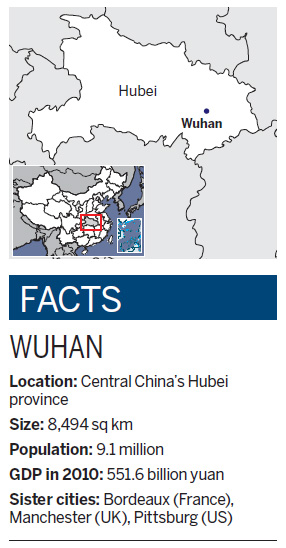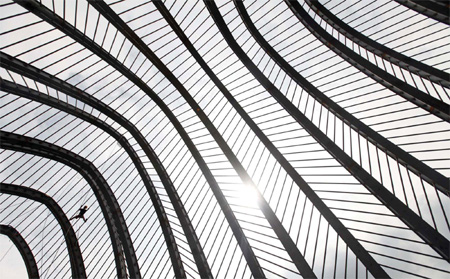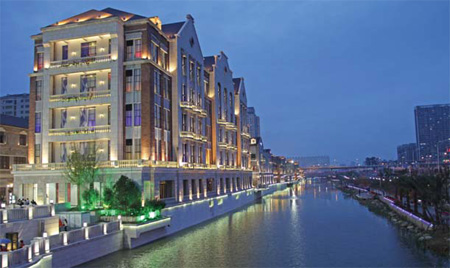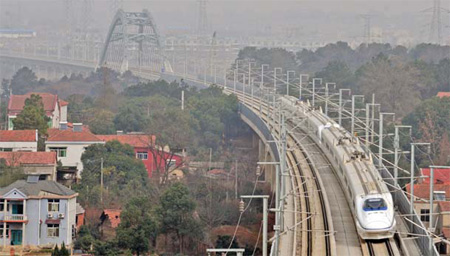Towering dreams
Updated: 2011-10-14 08:46
By Meng Jing and Zhou Lihua (China Daily)
|
|||||||||
|
|
Big-ticket infrastructure projects give Wuhan an edge in attracting foreign investment
If city planners have their way, Wuhan could soon be the crown jewel that will channel more foreign investment into China.
The city of more than 9 million people, the capital of Hubei province in Central China, is in the throes of a massive urbanization drive that will soon see it have an entirely new subway system, with nearly more than 200 kilometers of track, two new airport terminals, a new financial district, a cultural district and a riverfront promenade.
|
||||
Wuhan's infrastructure projects are helping to shore up China��s economic growth and reduce the impact of sluggish foreign trade. Wuhan also has a rich legacy, as it was from here that the seeds of a modern China were sown through what is now called the 1911 Revolution.
Ugur Lee Kanbur, general manager of the Westin hotel in Wuhan, says it is these twin factors that prompted the Starwood Group to set up its first hotel in Hubei province in the city.
"Location and right timing are the decisive factors for success in the hospitality business," Kanbur says.
The hotel, which had a grand opening at the end of last month, was fully booked in early October before the centenary celebrations for the 1911 Revolution on Oct 10.
"We are looking to be the market leaders in Wuhan by next year," says Kanbur, adding that Westin is the only Western luxury hotel in Wuhan.
 |
Kanbur says that the 1911 Revolution is not the only reason for Starwood to be present in Wuhan. "More importantly, it is the rapid development and transformation of the city and the question of being in the right place at the right time."
Today the 1911 Revolution is a distant memory in Wuhan, as several of the historic buildings have made way for new gleaming glass and steel edifices. Apart from subway lines, there are several projects for new roads and road widening. Construction sites throughout the city sport the catchy slogan "Today's inconvenience is for tomorrow's convenience".
Despite the inconveniences, companies are not complaining. "The city can be a little dusty now. But the potential of the city will keep growing as long as it continues to build something," says Kanbur.
"With the kind of development that is going on in the city, I would not be surprised if it stands on par with or overtakes cities such as Shenzhen and Guangzhou in the next five years.
"The icing on the cake for the city will be the slew of investments that will come from multinational companies and foreign investors."
Kanbur says Wuhan will be the top draw for global hotel chains, fashion brands and supermarkets. Justifying such claims has been the buzz in the hospitality business in recent times.
Sheraton Hotel, Westin's sister brand in the United States, and Ritz-Carlton, the luxury brand with no room priced below 2,500 yuan per night in China, are considering luxury hotels in Wuhan.
Big fashion brands such as the Sweden-headquartered H&M and the Spain-based ZARA arrived in Wuhan last year. Yet another biggie in the retail front Marks & Spencer (M&S) is setting up its sixth outlet in China in Wuhan rather than Beijing or Guangzhou.
M&S opened its first store in China in Shanghai in 2008, and now has four outlets in the city and another in Ningbo, Zhejiang province.
Qiu Lei, project director of Langold Real Estate, a Wuhan firm that focuses on developing commercial property projects, such as shopping centers, says Wuhan's business landscape is also fast changing with the infrastructure upgrade.
"Earlier it was not unusual to see middle-class people from Wuhan going to Shanghai, Guangzhou or even Hong Kong for shopping. That has changed now. Before the new shopping centers and modern infrastructure, many foreign brands perceived Wuhan as a third- or fourth-tier city," Qiu says.
As the capital of Hubei province, which is one of the six provinces that make up China's central hinterland, Wuhan is certainly no third- or fourth-tier city. But no one can ignore the economic gap between Wuhan and the first-tier cities in coastal China.
|
|
Despite strong growth in the past five years, Wuhan's gross domestic product (GDP) reached only 500 billion yuan last year, whereas Guangzhou in Guangdong province reported GDP of 1 trillion yuan.
But that gap is shrinking. Rising labor and output costs are crimping margins and profits for businesses in the coastal regions and many of them are moving inland. The State Council named Wuhan the center of Central China last year, and hopes to make it a powerhouse and an alternative destination for foreign investment. But the local government of Wuhan has even more ambitious plans. The city wants to be the national economic leader and not just that of Central China during the 12th Five-Year Plan (2011-2015).
"There are 5,000 construction sites in the city, which is more than all the construction sites in Europe put together," says Lan Hongbo, standing vice-director of Wuhan's investment promotion bureau.
The large number of construction sites does bring dust to the city and strain to the traffic system, but improved infrastructure is one of the key elements in attracting future investment, Lan says.
"Investors will evaluate the overall situation of a city, such as location, transport facilities, labor and raw material costs and infrastructure facilities. With a better infrastructure, we can certainly hope to attract more investors," he says, adding that his bureau has witnessed a rapid increase in investment in Wuhan over the past two to three years.
The number of Fortune 500 companies in Wuhan has grown from 60 to 81 in the past five years. Over $13 billion of foreign investment has come into Wuhan during the same period with an average annual increase of 13.6 percent.
Domestic investment has also risen during the period with a record high of 50.6 billion yuan investment in 2010, according to data from the local government. But the crown jewel of all the investment that Wuhan has attracted is undoubtedly real estate, Lan says.
"Can you imagine that Dalian Wanda Group has six plazas in Wuhan? The newly opened Han Street project alone cost 50 billion yuan," he says.
Wanda Group is one of China's top real estate developers with revenues of over 65 billion yuan in 2010. The real estate giant has four projects in Beijing and four in Shanghai, but in Wuhan it plans to develop seven or eight, according to the company's CEO Wang Jianlin.
The 1,500-meter Han Street, opened on Sept 30, is part of Wuhan central culture district, the largest single investment in Wanda Group's history in China. The project located near East Lake is a commercial complex sprawling 1.8 square kilometers, which includes five-star hotels, grade A office buildings, waterfront mansions and Han Street, said to be the longest pedestrian street in the world, which has been designed to become China's Fifth Avenue with not only fashion and luxury brands but also cultural destinations such as museums and theaters.
"It is impossible for first-tier cities such as Beijing, Shanghai and Guangzhou to offer such huge land parcels at such prime locations. Companies are also not keen on undertaking such mammoth projects in remote cities even if it comes with assurances of huge land parcels. It was therefore inevitable that we chose Wuhan for the project," says Wang from the Wanda group.
Shanghai-based Greenland Group, another big real estate developer, is also coming up with a mega project in Wuhan. The company is setting up two projects, including a 606-meter-high landmark skyscraper, which will be the third tallest building in the world after the 828-m Burj Khalifa Tower in Dubai and the 632-m Shanghai Tower when completed in 2017.
"We have been following the development of Wuhan since 2000. Back then, we did not think the city was ready," says Lu Zhenxing, marketing director for Hubei province at Greenland Group.
Wuhan's progress in the five past years is what prompted the change in the company strategy. Wuhan's GDP in 2005 was 200 billion yuan and is expected to reach 1 trillion yuan by 2015, according to the local government's 12th Five-Year Plan (2011-2015).
The Wuhan-centered high-speed rail network, expected to reshape China's transport landscape, is scheduled for completion in 2013. The network will reduce traveling time between Wuhan and major destinations such as Beijing, Shanghai and Guangzhou to four hours.
"Wuhan is within easy reach of China's major economic powerhouses of Shanghai, Guangzhou and Chongqing, all of which lie within a 1,200 km radius of the city. The high-speed rail network emphasizes Wuhan's locational advantage. We think Wuhan needs and deserves a landmark skyscraper in the near future," says Lu.
Such mega projects and the fast-changing skyline reinforce the confidence of investors.
"Our hotel's rooms are currently priced at least 20 percent to 30 percent lower than other Westin hotels in first-tier cities across China. I believe that we can catch up on the price front in the next five years in tandem with the booming development in Wuhan," Kanbur says.
|
|














